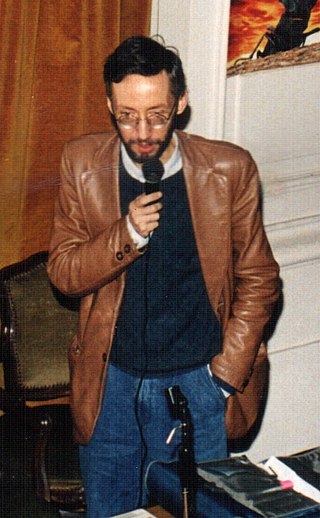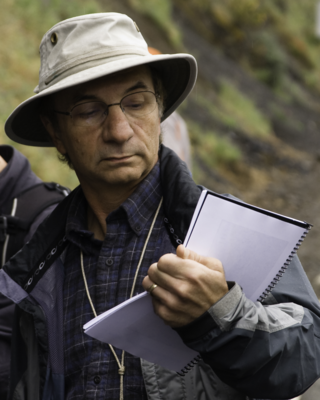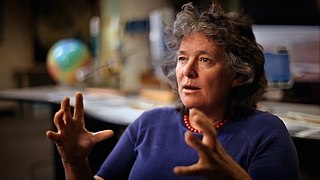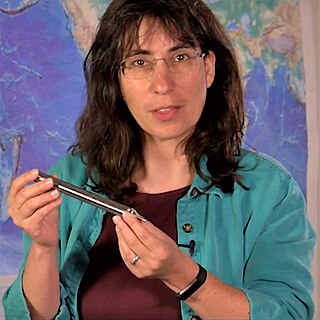
The University of California, Santa Cruz is a public land-grant research university in Santa Cruz, California. It is one of the ten campuses in the University of California system. Located on Monterey Bay, on the edge of the coastal community of Santa Cruz, the main campus lies on 2,001 acres (810 ha) of rolling, forested hills overlooking the Pacific Ocean. As of Fall 2022, its ten residential colleges enroll some 17,500 undergraduate and 2,000 graduate students. Satellite facilities in other Santa Cruz locations include the Coastal Science Campus and the Westside Research Park and the Silicon Valley Center in Santa Clara.

Sandra Moore Faber is an American astrophysicist known for her research on the evolution of galaxies. She is the University Professor of Astronomy and Astrophysics at the University of California, Santa Cruz, and works at the Lick Observatory. She has made discoveries linking the brightness of galaxies to the speed of stars within them and was the co-discoverer of the Faber–Jackson relation. Faber was also instrumental in designing the Keck telescopes in Hawaii.
The Harold C. Urey Prize is awarded annually by the Division for Planetary Sciences of the American Astronomical Society. The prize recognizes and encourages outstanding achievements in planetary science by a young scientist. The prize is named after Harold C. Urey.

Erik Ian Asphaug is a Norwegian American planetary science professor in the School of Earth and Space Exploration at University of Arizona. Asphaug received his bachelor's degree in mathematics and English from Rice University and his PhD in planetary science from the University of Arizona.
Jean-Luc Margot is a Belgian-born astronomer and a UCLA professor with expertise in planetary sciences and SETI.

Don Lynn Anderson was an American geophysicist who made significant contributions to the understanding of the origin, evolution, structure, and composition of Earth and other planets. An expert in numerous scientific disciplines, Anderson's work combined seismology, solid state physics, geochemistry and petrology to explain how the Earth works. Anderson was best known for his contributions to the understanding of the Earth's deep interior, and more recently, for the plate theory hypothesis that hotspots are the product of plate tectonics rather than narrow plumes emanating from the deep Earth. Anderson was Professor (Emeritus) of Geophysics in the Division of Geological and Planetary Sciences at the California Institute of Technology (Caltech). He received numerous awards from geophysical, geological and astronomical societies. In 1998 he was awarded the Crafoord Prize by the Royal Swedish Academy of Sciences along with Adam Dziewonski. Later that year, Anderson received the National Medal of Science. He held honorary doctorates from Rensselaer Polytechnic Institute and the University of Paris (Sorbonne), and served on numerous university advisory committees, including those at Harvard, Princeton, Yale, University of Chicago, Stanford, University of Paris, Purdue University, and Rice University. Anderson's wide-ranging research resulted in hundreds of published papers in the fields of planetary science, seismology, mineral physics, petrology, geochemistry, tectonics and the philosophy of science.
Nader Pourmand is a Professor of Biomolecular Engineering leading the Biosensors and Bioelectrical Technology Group at the Baskin School of Engineering at the University of California Santa Cruz, Baskin School of Engineering.

Paolo Farinella was an Italian scientist very active in the field of planetary science and in particular in the study of asteroids and small bodies of the Solar System.

Donald James DePaolo is an American professor of geochemistry in the department of earth and planetary science at the University of California, Berkeley and associate laboratory director for energy and environmental sciences at the Lawrence Berkeley National Laboratory.

Frances "Fran" Bagenal is a Professor Emerita of Astrophysical and Planetary Sciences at the University of Colorado Boulder and a Senior Research Scientist at the Laboratory for Atmospheric and Space Physics in the fields of space plasmas and planetary magnetospheres.

Devana Chasma is a weak extensional rift zone on Venus, with a length of 4000 km, a width of 150–250 km, and a depth reaching 5 km. Most of the faults are facing north–south. The rift is located in Beta Regio, a 3000 km rise created by volcanic activity. Mantle plumes rising from the bottom are the reason behind the formation of the rift zone. The slow extension rates in the rift may be driven by the same reason.

Konstantin Batygin is an American astronomer and Professor of Planetary Sciences at Caltech.
Sarah T. Stewart-Mukhopadhyay is an American planetary scientist known for studying planet formation, planetary geology, and materials science. She is a professor at the University of California, Davis in the Earth and Planetary Sciences Department. She was a professor at Harvard University Department of Earth and Planetary Sciences from 2003 to 2014.
The Paolo Farinella Prize is named after Paolo Farinella. The prize recognizes significant contributions in the fields of planetary sciences, space geodesy, fundamental physics, science popularization, security in space, weapons control, and disarmament. Recipients must be under the age of 47 to qualify for the prize.

James Zachos is an American paleoclimatologist, oceanographer, and marine scientist. He is currently a professor in the Department of Earth and Planetary sciences at University of California, Santa Cruz where he was elected to the National Academy of Sciences in 2017. His research focuses on the biological, chemical, and climatic evolution of late Cretaceous and Cenozoic oceans, and how past climatic conditions help improve forecasts of the consequences of anthropogenic carbon emissions on future climate change.
Suzanne E. Smrekar is an American geophysicist and Deputy Principal Investigator for the Mars InSight lander and the principal investigator for the planned VERITAS space probe to Venus.

Emily E. Brodsky is a Professor of Earth Sciences at the University of California, Santa Cruz. She studies the fundamental physical properties of earthquakes, as well as the seismology of volcanoes and landslides. In 2023, she was elected to the National Academy of Sciences.
Kelsi N. Singer (born 1984) is an American planetary scientist who is a senior research scientist at the Southwest Research Institute (SwRI) in Boulder, CO. She is a co-investigator and deputy project scientist of NASA's New Horizons mission studying the geomorphology and geophysics of the Pluto system and of Arrokoth (2014 MU69).
Thorne Lay is an American seismologist. He was born in Casper, Wyoming in 1956, and raised in El Paso, Texas. He is a professor of earth and planetary sciences at the University of California, Santa Cruz.
Richard G. Gordon is an American geophysicist, known for his research on global tectonics, including global plate motions and palaeomagnetism. He is noteworthy for leading two global plate motion projects: NUVEL and MORVEL. In the geosciences, NUVEL and MORVEL are standard models for global plate motions.










